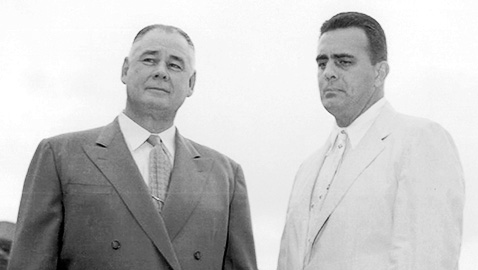By Tom Mattingly
Does anybody in the reading audience remember the first time they went to a game at Shields-Watkins Field or, after the 1962 Alabama game, Neyland Stadium?
For me, the day was Oct. 5, 1957, when the Vols squared off against Mississippi State. Kickoff time was 2 p.m. The game started an 8-year run in which the Vols and State squared off the first Saturday in October.
Frank “Red” Bailes wrote the game story for the Knoxville News-Sentinel.
You may find this hard to believe, but Red’s game story pegged the attendance at 25,000, in a stadium with a seating capacity of 46,390.
Bowden Wyatt was in his third year as Vol head coach, with an SEC title in his pocket from the 10-1 1956 season. The former Vol captain, 1938 All-American, and 1997 College Football Hall of Fame honoree had previously won league titles at Wyoming and Arkansas, making him one of a handful of coaches winning conference titles in three leagues.
The Vols had lost to eventual national champ Auburn 7-0 the week before, so fans were very interested in how the team might bounce back.
Offensive guard Bill Johnson and wingback Bill Anderson were the Vol captains. Blocking back Stockton Adkins would win the Jacobs Trophy as the SEC’s best blocker for a second consecutive season.
I remember sitting in Section V and being awed by the ambience of the stadium, John Ward on the public address, the green grass, the numbers on the field, Tennessee on the east side, Mississippi State on the west. The Vols wore the orange shirts, with Mississippi State in white. George Mooney and Bob Foxx covered the game on the Vol Network.
There was no upper deck, just the horseshoe at the south end and bleachers at the north end.
The facts of the game are simple. Tennessee trailed 9-7 late in the game, with Vol fans starting to stream to the exits, trying to rationalize an 0-2 start the year after winning a conference title.
Vol defenders forced a punt with fewer than two minutes remaining. The single-wing was not really known as a comeback offense, but there was enough time remaining to have some semblance of hope.
Bobby Gordon, the Pulaski senior who would go down in Vol history as part of a titanic collision with Texas A&M’s John David Crow in the 1957 Gator Bowl, was back to return the punt.
He fielded the ball at the Vol 45, headed toward the east sideline, and found the express lane to the north end. Vol fans rushed back from the exits as the crowd noise swelled.
The News-Sentinel coverage the next morning had six pictures of Gordon’s run from start to finish atop p. 1 of the sports section.
The Vols were 7-3 in the regular season and capped the campaign with a 3-0 win over Bear Bryant’s last Texas Aggie team. The final AP ranking was No. 13.
After a 6-3-1 season in his first year, an 18-4 mark in 1956 and 1957 was Wyatt’s high point in his Tennessee coaching career.
There was a 4-6 record in 1958, a 5-4-1 slate in 1959 that included major upsets over No. 3 Auburn (3-0) and No. 1 LSU (14-13), a 6-2-2 mark in 1960 that somehow did not merit a bowl game, a 6-4 worksheet in 1961 again without a bowl game, and a 4-6 mark in 1962.
The times in college football they were a-changing, as Bob Dylan wrote in 1963. Wyatt was let go in June that year after pushing a sportswriter into a hotel swimming pool at the SEC meetings. Jim McDonald bridged the gap for one season before Bob Woodruff brought in Doug Dickey from Arkansas in December 1963 to right the ship.
Dickey had played for Woodruff at Florida in the early 1950s and had quarterbacked the Gators in a 27-12 loss to the Vols in 1952.
Dickey’s hiring put the single-wing in mothballs. The Vols won big in his second year in 1965 and the Vols would be consistent winners from that point on, with occasional bumps in the road along the way. But there were more good moments than bad by a long shot.
For a youngster in Knoxville, however, experiencing the game that day was akin to giving a wolf his first taste of sheep.
Throughout the years, Tennessee football has been replete with great moments, moments that define a storied tradition that is still evolving. These are stories that are worth retelling.







